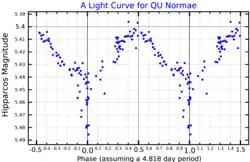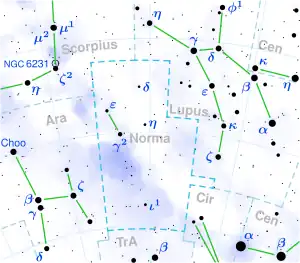QU Normae
| Observation data Epoch J2000.0 Equinox J2000.0 (ICRS) | |
|---|---|
| Constellation | Norma |
| Right ascension | 16h 29m 42.32777s[1] |
| Declination | −46° 14′ 35.6309″[1] |
| Apparent magnitude (V) | 5.37[2] (5.27 - 5.41[3]) |
| Characteristics | |
| Spectral type | B1.5 Iap[4] |
| U−B color index | −0.44[2] |
| B−V color index | +0.62[2] |
| Variable type | α Cyg[3] |
| Astrometry | |
| Radial velocity (Rv) | −14.80 ± 3.2[5] km/s |
| Proper motion (μ) | RA: −3.403 mas/yr[1] Dec.: −4.151 mas/yr[1] |
| Parallax (π) | 0.6505±0.0794 mas[1] |
| Distance | approx. 5,000 ly (approx. 1,500 pc) |
| Absolute magnitude (MV) | −7.50[6] |
| Details | |
| Mass | 43[7] M☉ |
| Radius | 110[7][a] R☉ |
| Luminosity | 417,000[6] L☉ |
| Surface gravity (log g) | 2.00[7] cgs |
| Temperature | 17,000[7] K |
| Rotational velocity (v sin i) | 44[7] km/s |
| Other designations | |
| QU Normae, HD 148379, HIP 80782, HR 6131, CD−45°10697 | |
| Database references | |
| SIMBAD | data |
QU Normae, also known as HR 6131, is a blue supergiant star in the constellation Norma. It is also a variable star, thought to be an α Cyg variable.
The apparent magnitude of QU Normae varies somewhat irregularly between 5.27 and 5.41. The General Catalogue of Variable Stars quotes a period of 4.818 days,[3] but other research only shows likely periods longer than 10 days.[8]

QU Normae has a spectral type B1.5 Ia, a luminous supergiant that has swollen and cooled off the main sequence. Surface abundances suggest that it has not yet passed through a red supergiant phase.[6] Around 5,000 light-years distant, it shines with a luminosity approximately 417,000 times that of the Sun and has a diameter around 110 times that of the Sun.
Notes
- ^ Calculated using surface gravity and mass, via the equation log(R/R☉) = 2.22 + 0.5 • log(M/M☉) − 0.5 • log(g).
References
- ^ a b c d Vallenari, A.; et al. (Gaia collaboration) (2023). "Gaia Data Release 3. Summary of the content and survey properties". Astronomy and Astrophysics. 674: A1. arXiv:2208.00211. Bibcode:2023A&A...674A...1G. doi:10.1051/0004-6361/202243940. S2CID 244398875. Gaia DR3 record for this source at VizieR.
- ^ a b c Ducati, J. R. (2002). "VizieR Online Data Catalog: Catalogue of Stellar Photometry in Johnson's 11-color system". CDS/ADC Collection of Electronic Catalogues. 2237. Bibcode:2002yCat.2237....0D.
- ^ a b c Samus, N. N.; Durlevich, O. V.; et al. (2009). "VizieR Online Data Catalog: General Catalogue of Variable Stars (Samus+ 2007-2013)". VizieR On-line Data Catalog: B/GCVS. Originally Published in: 2009yCat....102025S. 1. Bibcode:2009yCat....102025S.
- ^ Chini, R.; Hoffmeister, V. H.; Nasseri, A.; Stahl, O.; Zinnecker, H. (2012). "A spectroscopic survey on the multiplicity of high-mass stars". Monthly Notices of the Royal Astronomical Society. 424 (3): 1925. arXiv:1205.5238. Bibcode:2012MNRAS.424.1925C. doi:10.1111/j.1365-2966.2012.21317.x. S2CID 119120749.
- ^ Gontcharov, G. A. (2006). "Pulkovo Compilation of Radial Velocities for 35 495 Hipparcos stars in a common system". Astronomy Letters. 32 (11): 759–771. arXiv:1606.08053. Bibcode:2006AstL...32..759G. doi:10.1134/S1063773706110065. S2CID 119231169.
- ^ a b c Lennon, D. J.; Dufton, P. L. (1986). "Evolutionary effects on the surface abundances of an early-type supergiant". Astronomy and Astrophysics. 155: 79. Bibcode:1986A&A...155...79L.
- ^ a b c d e Fraser, M.; Dufton, P. L.; Hunter, I.; Ryans, R. S. I. (2010). "Atmospheric parameters and rotational velocities for a sample of Galactic B-type supergiants". Monthly Notices of the Royal Astronomical Society. 404 (3): 1306. arXiv:1001.3337. Bibcode:2010MNRAS.404.1306F. doi:10.1111/j.1365-2966.2010.16392.x. S2CID 118674151.
- ^ Van Leeuwen, F.; Van Genderen, A. M.; Zegelaar, I. (1998). "Hipparcos photometry of 24 variable massive stars (α Cygni variables)". Astronomy and Astrophysics Supplement Series. 128: 117–129. Bibcode:1998A&AS..128..117V. doi:10.1051/aas:1998129.
- ^ "Hipparcos Tools Interactive Data Access". Hipparcos. ESA. Retrieved 8 December 2021.
